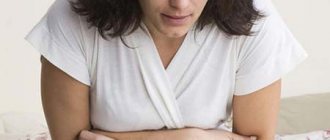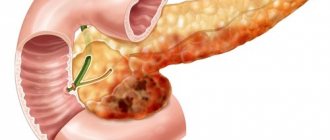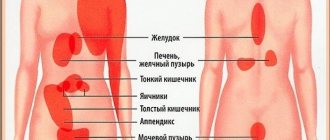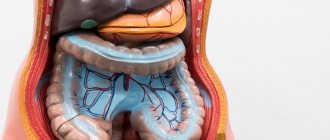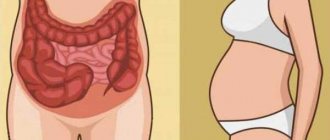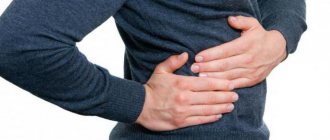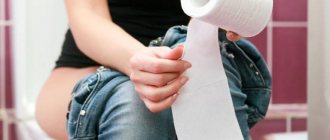Pathologies of the diaphragm
This is the main respiratory muscle, which conditionally separates the chest and abdominal cavity. As a rule, the cause of pain on the left under the ribs in front when inhaling is a diaphragmatic hernia, during the development of which the lower part of the stomach moves upward due to an increase in the lumen of the esophagus.
This pathological condition can occur against the background of:
- regular high-intensity physical activity;
- pregnancy;
- chronic constipation;
- excess body weight;
- pathologies of the gastrointestinal tract;
- respiratory diseases.
Diaphragmatic hernia is a serious illness, the danger of which is that over time the functioning of the digestive system, heart and lungs is increasingly disrupted.
Main symptoms of the disease:
- Aching pain on the left under the ribs when inhaling air. It is permanent.
- Frequent episodes of regurgitation (almost after every meal).
- Heartburn.
- Belching air.
- Difficulty swallowing food.
- Bloating.
- Cough.
- Tachycardia.
Treatment of pathology involves the use of surgical methods, during which the surgeon returns the stomach to its place and sutures the lumen of the esophagus. Conservative therapy in this case is ineffective. Medications only temporarily reduce the severity of symptoms.
Nature of pain
Pain in the left hypochondrium is a symptom of many diseases. This is due to the fact that almost all the main internal organs of a person are located on the left under the ribs: part of the stomach, diaphragm, intestines, pancreas, spleen, left kidney. Therefore, the nature of pain is very different. However, it is the type of discomfort under the ribs on the left that is important for correct diagnosis and determines the specialist who will carry out the treatment.
Stitching sensation on exertion
Pain under the left rib can occur during physical overload: running, fast walking, jumping. This is not scary, it occurs in absolutely healthy people, goes away quickly and indicates insufficient warm-up before training or too sudden movements. However, discomfort requires stopping, resting, relaxing your arms, shoulders, and deep breathing. You should not test your body’s strength: exhale sharply, pressing your palm on the painful point, leaning forward. You can repeat the exercise a couple of times, and then run on.
Typically, sharp stabbing pain on the left appears if training is started immediately after eating. It takes at least an hour and a half for the digestive system to cope with its main work.
Dagger pain syndrome
A sudden, sharp pain in the left side under the ribs looks completely different when it has nothing to do with physical activity. This is always a reason for emergency medical intervention, since the cause may be rupture of the renal pelvis, spleen, perforation of the intestinal wall, stomach, abdominal myocardial infarction, acute pancreatitis.
Post-traumatic pain
It happens that painful discomfort in the left side under the ribs occurs when inhaling after injuries, road accidents and can be a sign of dangerous damage to internal organs that threatens life.
Dull pain in the left hypochondrium
Diffuse, dull pain under the ribs on the left, which occurs periodically for a long time, may be a symptom of gastrointestinal pathology: cholecystitis, gastritis, pancreatitis or splenomegaly with autoimmune pathologies, systemic diseases, sepsis, bacterial infections. This condition requires a complete clinical and laboratory examination.
It's a dull pain
Constant nagging pain on the left under the ribs is a sign of sluggish colitis or duodenitis, and when vomiting is associated - ulcerative ulcer. Pain in the left hypochondrium anteriorly
may be a sign of angina pectoris, ischemic heart disease, pre-infarction condition. In addition, pain that occurs in the left upper abdomen is provoked by:
- cardiomyopathy, myocarditis;
- intercostal neuralgia;
- rupture or infarction of the spleen due to arterial thrombosis;
- neoplasms of internal organs;
- diaphragmatic hernia, injuries;
- rheumatism;
- left-sided pneumonia, pleurisy, which occurs at the bottom of the left lung.
Left-sided intercostal neuralgia
This term refers to a pathological condition, the symptoms of which are similar to those of angina pectoris or myocardial infarction. It is not dangerous in itself, but may be a symptom of diseases characterized by irritation or compression of the nerves located between the ribs.
Reasons for the development of the pathological condition:
- osteochondrosis in advanced form;
- kyphosis;
- spondylitis;
- malignant neoplasms in the spine;
- intoxication of the body;
- aortic aneurysm;
- diabetes;
- multiple sclerosis;
- abnormal development of internal organs;
- injuries;
- hypothermia;
- stress;
- deficiency of B vitamins;
- tight underwear for women.
With this form of neuralgia, unpleasant sensations can radiate to the area of the heart, chest, shoulder blades, and often the left side under the ribs hurts when inhaling. The severity of symptoms increases with coughing, sneezing, and playing sports. The pain with intercostal neuralgia is burning. Over time it becomes aching.
Treatment of the disease is carried out using conservative methods. The treatment regimen directly depends on the cause of the pathology. It is important to consult a doctor when the first symptoms appear, since only a specialist can distinguish neuralgia from angina pectoris and myocardial infarction.
Abdominal pregnancy
Occurs in no more than 0.5% of all cases of pregnancy outside the uterine cavity. However, during abdominal pregnancy, the fertilized egg is often attached to full-blooded, well-supplied organs, which include the spleen, intestinal mesentery, and liver, which is why women may experience pain under the ribs on the left.
In rare cases, pain in the left hypochondrium may occur due to abdominal pregnancy. Despite the apparent absurdity of this situation, similar cases have been recorded in medicine. You can use an online consultation with a doctor on our website in a paid or free mode to determine the severity of your problem.
The causes of pain in the left hypochondrium can be various pathological processes. Some of them require intensive care or even surgical intervention (rupture of the spleen, perforation of a stomach ulcer, etc.).
Any symptoms should prompt you to see a doctor. Only a competent specialist can correctly determine why pain occurs, comparing it with other manifestations of various pathologies, and prescribe effective treatment.
Learn about the causes of pain under the left rib in the front from the video:
Useful articles on the topic: Kidney disease in women: symptoms, diagnosis and treatment Pain in the right side under the ribs in front - what could it be?
This article has been verified by a current qualified physician, Victoria Druzhikina, and can be considered a reliable source of information for site users.
Bibliography
1. https://base.garant.ru/70349708/ https://gpfm.ru/assets/image%20for%20events/bol-v-zhivote.pdf
Rate how useful the article was
4.7 33 people voted, average rating 4.7
Did you like the article? Save it to your wall so you don’t lose it!
Diseases of the respiratory system
Pain on the left side under the ribs in front when inhaling may indicate the development of pleurisy or pneumonia. In the first case, the pathological process affects the lungs, in the second - the serous membrane that surrounds them.
Pneumonia is an acute infectious disease. The clinical picture and severity of symptoms directly depend on the cause, gender and age of the patient.
General symptoms of pathology:
- Increased body temperature. The rise comes sharply.
- General signs of intoxication of the body (weakness, rapid onset of fatigue, headache).
- Dry cough. Appears in 3-5 days. Gradually it turns into a wet form, accompanied by sputum.
- Painful sensations in the chest area, aggravated by inhalation. They can radiate to the area of the left or right hypochondrium, and the pathological process can also be bilateral.
- Dyspnea.
Pleurisy is a disease that, as a rule, is not independent in nature, but accompanies a number of other pathologies of the respiratory system. The disease can have both a dry and exudative form.
The clinical picture of the disease directly depends on the underlying cause. Common symptoms include: pain in the left or right hypochondrium, worsening with inhalation; reflex painful cough; increased body temperature; chills; weakness.
Treatment of pathology consists of eliminating the underlying disease and reducing the severity of symptoms.
Determining the presence or absence of disease
During the development of what disease does pain occur in the intestines on the left side? In order to determine the disease that provokes the occurrence of painful sensations, you need to listen to your body and analyze the main symptoms that cause discomfort:
- With chronic diseases of the gastrointestinal tract, cancer, intestinal obstruction or volvulus, pancreatitis, the intestines hurt greatly.
- Colic occurs due to spasms, intoxication, the introduction of pathological microorganisms into the body, or due to mechanical damage to the intestines.
- With ulcerative colitis, appendicitis, and infectious diseases of the gastrointestinal tract, acute, recurring pain develops in the intestines on the left side.
- Due to intestinal irritation, prolonged cutting pain develops in the lower abdomen.
- With gastritis or inflammation of the esophageal mucosa, the patient is bothered by pressing or bursting pain in the intestines.
If severe pain occurs in the intestines, it is important to determine the location of the unpleasant symptom. The pain can be felt on the right and left, near the ilium, closer to the navel, or radiate to the entire abdomen:
- Colic is a common cause of left intestinal pain. If the pain is localized in the lower abdomen or in the navel area, then we can say that the patient has enteritis, colic or worms.
- With appendicitis and diseases of the colon, discomfort occurs in the right iliac region.
- With dysentery and sigmoid colon disease, the pain is localized on the left side of the iliac region.
If the intestines hurt on the right and left, this indicates that the inflammatory process affects several segments of the intestine or a duodenal ulcer develops. Under such conditions, self-medication is prohibited. Only a doctor should prescribe medications. The dose and duration of treatment is determined by the doctor.
Heart pathologies
In the human body, the diaphragm is closely connected with the central circulatory organ. That is why, in the presence of cardiac pathologies, the process of inhaling air can be accompanied by pronounced painful sensations.
As a rule, patients in this case are diagnosed with one of the forms of cardiomyopathy. The most dangerous is considered to be dilation, in which the heart becomes flabby and cannot fully perform its function. The causes of this pathology are unknown.
In addition to pain when breathing on the left under the ribs, patients complain of shortness of breath after performing any physical activity, dizziness, a constant feeling of weakness, swelling of the lower extremities, sleep disturbances, and frequent episodes of fainting.
For cardiomyopathy, symptomatic treatment is carried out. The prognosis for the presence of the disease is usually unfavorable. Until recently, the only option for patients was a donor organ transplant. But the difficulty is that the queue of patients is extremely impressive. However, finding a donor heart is almost impossible. Currently, the stem cell treatment method is used in practice.
Splenic rupture
This is an organ located in the hypochondrium on the left side. The spleen is a kind of storage facility for red blood cells. It is involved in immune processes and is involved in cleansing liquid connective tissue from harmful substances.
When the spleen ruptures, a stabbing pain occurs when inhaling on the left side under the ribs. The abdominal cavity is damaged and blood leaks into it. Against this background, the pain when inhaling on the left under the ribs on the side increases significantly. Over time, it covers the entire abdomen. It becomes extremely difficult for a person to swallow air.
In addition to pain when inhaling under the rib on the left, the following symptoms are observed:
- cyanosis of the skin in the area where the spleen is located;
- chills;
- nausea turning into vomiting;
- high body temperature;
- arterial hypotension.
If there are signs of organ rupture, you must immediately call an ambulance. But even with timely intervention by doctors, the spleen can be saved only in 1% of cases. Therefore, the main treatment for this condition is complete removal of the organ.
Nature of pain
So, the pain under the ribs on the left can be acute, permanent and significantly hinder movement. Such sensations can be localized at one point and can intensify when pressing on the focus. This indicates the presence of an inflammatory process or a pinched nerve. Also, pain conditions can be constant, dull and aching. There are often cases when pain is accompanied by swelling and discoloration of the skin. It can cause an increase in body temperature and cause dizziness, nausea, vomiting, and digestive system upset.
There can be many reasons for the occurrence of such pain. We know that pain varies in its presentation. Let's try to understand the main types.
Acute pyelonephritis
If your left side hurts under the ribs when you inhale, this may indicate kidney pathology. The term “acute pyelonephritis” refers to an inflammatory process in which the pyelocaliceal system and intermediate tissue of the organ are involved.
The main reason for the development of the disease is the spread of infection to the kidneys from the lower urinary tract. This occurs in the presence of one or more provoking factors.
These include:
- intestinal dysbiosis;
- vaginal dysbiosis, an increase in its acidity;
- hormonal imbalance;
- frequent change of sexual partners (for women);
- increased intrarenal pressure;
- ureteral strictures;
- prostate adenoma or cancer;
- stones in the ducts through which urine is excreted from the body;
- hypothermia;
- diabetes;
- pregnancy;
- overwork;
- viral infections;
- hypovitaminosis.
If the left side of the organ is affected, the disease can be suspected if the following signs are present:
- The urge to urinate becomes more frequent. In this case, urine is not released.
- When inhaling, the left side hurts under the ribs, the unpleasant sensations radiate to the abdominal cavity.
- General health worsens.
- Body temperature rises.
- A feverish state appears.
- Sweating increases.
Gradually, the pain with a deep breath on the left (under the ribs) reaches its maximum peak. Its severity decreases somewhat as you exhale. Coughing, sneezing, any physical activity - all this increases the intensity of painful sensations so much that a person may lose consciousness.
The key to successful treatment is timely provision of medical care. The prognosis is considered favorable if the disease subsides while taking medications. According to statistics, in 30% of patients the disease becomes chronic. At the same time, the risk of developing pathologies that pose a threat to the patient’s life remains.
Osteochondrosis
Currently, this is the most common spinal disease. During its development, degenerative-dystrophic changes in bone and cartilage tissue occur. According to statistics, about 90% of the world's population suffers from osteochondrosis.
The main reasons for the development of the disease:
- improper formation of the spine during intrauterine development;
- hereditary predisposition;
- the natural aging process of the body;
- disturbance of phosphorus and calcium metabolism;
- unbalanced diet;
- inactive lifestyle or, on the contrary, high-intensity physical activity;
- vibrations that are long-lasting or regular (for example, when driving);
- excess body weight;
- smoking;
- various types of injuries;
- weakness of muscle tissue in the back;
- scoliosis;
- flat feet;
- infectious diseases;
- constantly being in a state of stress;
- living in unfavorable environmental conditions;
- wearing uncomfortable shoes, including high-heeled models;
- pregnancy.
If, when you inhale, there is a stabbing sensation in the left side under the ribs, this is considered a symptom of thoracic osteochondrosis. In addition, a person may experience a feeling of numbness in the area of the heart and stomach. Often the pain radiates to the left shoulder blade or shoulder. The patient also experiences rapid onset of fatigue even with minimal mental and physical exertion.
In most cases, the treatment regimen for osteochondrosis includes the following points: medication, physical therapy, physiotherapy, massage, traction, kinesiotaping, diet.
Colic in the left hypochondrium in front
The patient is bothered by stabbing pain on the left side under the ribs. Symptoms indicate a disturbance in the functioning of the heart. Perhaps this is not the only reason. If colic appears under the left rib and is localized in front, this is a lesion of the abdominal organs.
Pancreatitis
Pancreatic disease. The organ produces enzymes and pancreatic juice and secretes into the duodenum. The disease clogs the ducts that allow secretions to enter the beginning of the small intestine. Enzymes begin to digest organ tissue. The lack of necessary substances in the duodenum leads to the formation of fatty, sticky and liquid stool. A symptom of pancreatitis is polyfecality or profuse bowel movements.
When the pancreas swells due to lack of bile outflow, pain is felt in the right side, back and right shoulder. Pancreatitis is often combined with liver disease – cholecystitis.
Pain in the gland occurs after eating. Colic does not cause severe discomfort and goes away after 2 hours either on its own or under the influence of medications. Additional symptoms that appear with pancreatitis:
- A feeling of heaviness appears.
- My stomach is rumbling a lot.
- Feeling that the stomach is full.
- Diarrhea.
There are acute and chronic forms of the disease. Eating large amounts of food causes an exacerbation of the disease. The pain becomes more intense, not only on the left side. The syndrome encircles the body, vomiting, high fever, and weakness are added.
If the pain syndrome appears suddenly, urgent hospitalization and surgical intervention are necessary. The operation prevents the occurrence of peritonitis and necrosis.
If there is a tumor in the pancreas, then there are no external signs for a long time, there is no pain in the hypochondrium. Only the increasing size of the organ puts pressure on the nearby viscera and causes pain under the left rib, and jaundice appears.
Gastritis, peptic ulcer
If the cause of the discomfort is gastritis or a stomach ulcer, then after eating the patient will feel a burning sensation in the chest and will feel nauseous.
Complications caused by peptic ulcer disease lead to severe pain. The pain is characterized as dagger-like, body temperature rises, and weakness occurs. Only surgery helps.
Gastric tumor does not appear in the early stages. The pain will begin to occur later. This will not be related to food; the colic under the ribs on the left side will be constant.
Gastritis, stomach ulcer
Often, when inhaling, the left side under the ribs hurts when this organ of the digestive system is damaged.
Gastritis refers to inflammation of the gastric mucosa, which disrupts the normal functioning of the stomach. The main reasons for the development of the disease:
- vital activity of pathogenic microorganisms Helicobacter pylori;
- unbalanced diet;
- excessive consumption of alcoholic beverages;
- taking certain medications (for example, painkillers, NSAIDs);
- helminthic infestations;
- prolonged exposure to stress;
- hereditary predisposition;
- autoimmune diseases;
- hormonal imbalance.
There are several forms of gastritis, each of which has specific symptoms. In order to recognize the disease, it is necessary to pay attention to the nature of the pain. Against the background of exacerbation of gastritis, when inhaling, there is a stabbing sensation in the left side, under the ribs. The intensity of pain always increases after any meal, drinking alcoholic beverages, taking non-steroidal anti-inflammatory drugs, or prolonged fasting.
Treatment of gastritis of any form is carried out using conservative methods.
A stomach ulcer is a chronic pathology, the consequence of which is trophic disorders. Changes in periods of exacerbation and remission occur very often, with relapses usually occurring in spring and autumn.
Pain when inhaling in the left hypochondrium appears due to intoxication of the body. In addition, the following conditions are symptoms of peptic ulcer:
- feeling of heaviness in the stomach after each meal;
- belching;
- nausea turning into vomiting;
- constipation;
- loss of appetite;
- a sharp decrease in body weight;
- increased formation and accumulation of gases;
- excessive sweating;
- coating on the tongue.
Treatment of the pathology is complex. It includes taking medications, physical therapy, and diet therapy. In very severe cases, surgery is performed, during which part of the stomach is removed.
Causes of pain on the side and front
The cause of the pain is the main task in solving the problem. Only if it is established why pain occurs in the left side under the ribs, the patient is prescribed appropriate treatment. Taking painkillers only brings temporary relief, and sometimes can harm the patient.
If your left side hurts under the ribs in front, then first of all you should think about the pathology of the digestive system. This can be an inflammatory or dystrophic process, in some cases an acute surgical pathology associated with a violation of the integrity of the organ.
If pain occurs in the left side in front, then one should think about spleen pathology only if more common diseases are excluded. Discomfortable sensations develop only when the splenic capsule is stretched or its integrity is violated (rupture as a result of injury). If the spleen is of normal size, then it cannot hurt, since there are no pain receptors in its parenchyma.
It is more convenient to consider the possible causes of pain in the front side in the form of a table.
| The organ whose damage is associated with pain | Possible pathology |
| stomach | gastritis (inflammatory or dystrophic process); peptic ulcer (including perforation of the ulcer with the development of peritonitis); tumors, malignant and benign; gastric cardia insufficiency |
| pancreas | pancreatitis (acute or chronic inflammation); tumors of malignant and benign nature |
| duodenum | duodenitis; peptic ulcer; neoplasms of the intestine itself or the ducts opening into it (cancer of the papilla of Vater); |
| colon | colitis; irritable bowel syndrome; malsorption syndrome; Crohn's disease; nonspecific ulcerative colitis |
| diaphragm | hiatal hernia; |
| spleen | damage due to trauma; splenomegaly in infectious diseases and blood diseases. |
If a woman’s left side hurts under the ribs, then gynecological pathology cannot be ruled out. But such localization of pain is atypical and should be considered last, after excluding more likely diseases. Discomfortable sensations are associated with the irradiation of pain - its spread to areas remote from the affected organ. The same rare situation is possible if a man’s left side hurts under the ribs.
At rest
If the left side hurts under the ribs at rest, then the condition is most often associated with pathology of the digestive tract. The occurrence of discomfort in the absence of physical stress allows one to suspect an inflammatory or degenerative process, but one that does not require emergency medical intervention.
After meal
If the left side hurts under the ribs after eating, this is due to an increase in the volume of the stomach and increased secretion of various digestive juices. The mechanical and chemical effect on the mucous membrane of the stomach or intestines increases - pain occurs. This symptomatology is typical for:
- gastritis, duodenitis or pancreatitis;
- peptic ulcer;
- hiatal hernia.
The occurrence of pain in the left hypochondrium after eating can be caused by eating a certain type of food (spicy, fried, salty) or a significant amount of food, especially after a long period of time between meals. This situation requires careful attention to your own diet and a scheduled visit to the doctor.
When walking or running
If the left side hurts under the ribs when walking or running, then the reason is insufficiency or excess of local blood circulation or pathology of the musculoskeletal system. Intense sports activity does not always correspond to a person’s physical capabilities - there is a deficiency in the inflow or outflow of blood from organs and tissues. Ischemia of the organ occurs or, conversely, the pressure in it increases. Both can lead to the development of pain.
Sports activities and fast walking are accompanied by additional stress on the spine. Against this background, it is possible that the nerve roots may be pinched and quite severe pain may occur.
In such cases, it is important to correctly assess your physical condition, balance the intensity of physical exercise, and when playing sports, be sure to warm up and gradually increase the load.
Side pain is a common problem for new runners.
When coughing
If the left side under the ribs hurts when you cough, the discomfort is most often due to pathology of the spinal column. A cough is a sharp exhalation, which is accompanied by contraction of the intercostal muscles, back and abdominal muscles. Nerve endings may be pinched and pain may occur. Usually this pain is short-lived and does not cause much concern.
If the left side under the ribs hurts when you inhale, this may be due to muscle pathology or the result of too intense physical activity. Such pain is rarely associated with pathology of the respiratory system.
Pathologies of the pancreas
Pancreatitis is most often diagnosed in patients. Against the background of its development, the functioning of the pancreas is disrupted. The disease can be both acute and chronic. In the first case, a person is bothered by pain in the left hypochondrium, which intensifies when inhaling; his appetite is impaired; vomiting appears; body temperature rises; diarrhea or, conversely, constipation develops. In the chronic form, patients complain of constantly feeling unwell, nausea, and flatulence.
Treatment of pancreatitis may include both conservative and surgical methods.
Localization of pain
Descriptions of a symptom will only help to preliminary determine the cause of its occurrence. To make an accurate diagnosis, you should contact a medical facility. Self-medication is acceptable in cases where the pain comes on suddenly, or a trip to the doctor is postponed for some reason. Delay in seeking professional help often results in complications of the disease. Signs of this condition are severe, prolonged, recurring pain.
What to pay attention to before visiting a doctor and clarifying the diagnosis:
- Understand your feelings in which place of the abdomen the pain is worse: on the left, closer to the sternum or directly under the ribs.
- Remember when pain appears: after physical activity, eating, stress.
- Note how often attacks occur, how they develop, whether pain increases when coughing or changing body position.
- Try to determine the nature of the pain, what it is: pressing, aching, sharp or bursting.
With appendicitis, discomfort first occurs in the upper abdomen. Dull pain in the stomach area and vomiting appear. After some time, a sharp pain occurs to the right of the navel, below the waist. In such cases, it is impossible to warm up the stomach. If you suspect appendicitis, it is not recommended to take painkillers on your own; you should consult a doctor as soon as possible.
